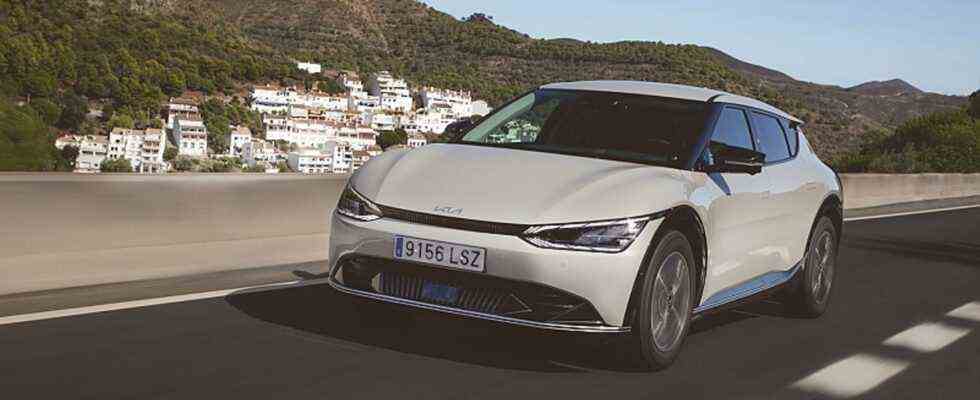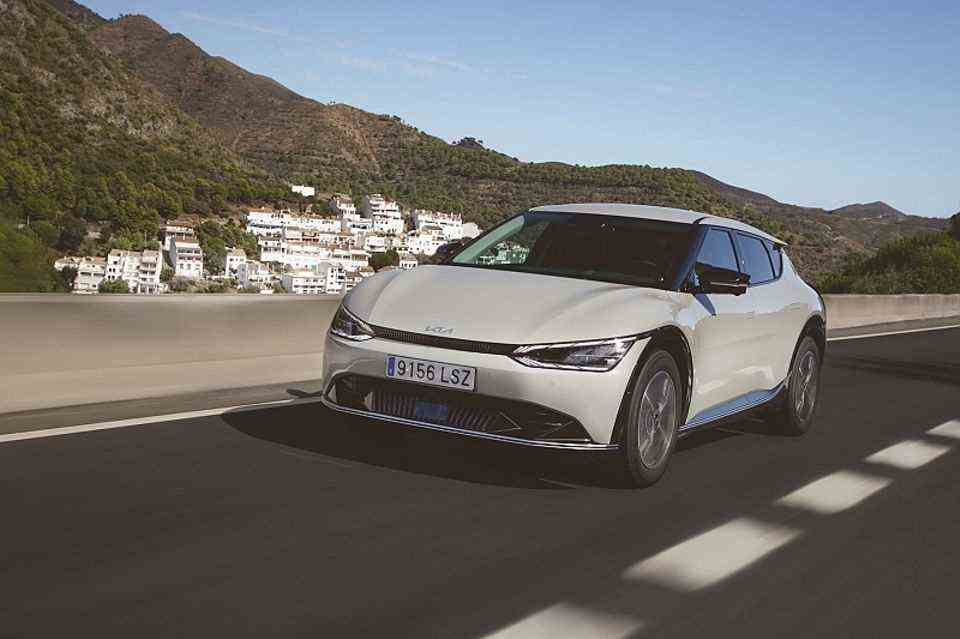Driving report: Kia EV6
Power bar
Kia EV6
© press-inform – the press office
Kia wants to stir up the market for electric cars with the EV6: long range, short charging times, sporty driving values, plenty of assistance systems and a generous guarantee should electrify customers.
If you press the start button, you think you’re sitting in the forest. The twittering of birds can be heard from all sides, and a gentle breeze makes leaves rustle. How does a car start? An electric car. The Kia EV6. The Korean provides background noises of your choice and mood: the sound of the sea, pattering rain, murmuring bars, boots crunching in the snow. And what does that say about the quality of an electric vehicle? Much. Because it reveals how much enthusiasm, imagination and love its developers put to work.
The EV6 from Kia marks a new generation of electric cars even without the chirping of birds. It finally makes e-mobility more or less suitable for everyday use. Example loading time. The Kia EV6 cannot be charged as quickly as a car with an internal combustion engine. But the loading time is bearable. With a battery charge of just 28 percent, we connected an EV6 with a 77.4 kWh battery to a fast charging station from Ionity in the Spanish hinterland. Less than 17 minutes later, the column showed an 87 percent charge level. That would just have been enough for a cup of tea. According to Kia, enough electricity for 100 kilometers is stored in just four minutes. Such fast charging is made possible by the 800-volt architecture that Kia has granted the EV6 and that delivers a charging power of 225 kW – provided you can find a suitable charging station. The Hyundai Ionic 5 also works on the same group platform E-GMP with 800 volts. Apart from Hyundai / Kia, only luxury electric vehicles such as the Porsche Taycan and the Audi E-tron GT currently have this high voltage on board. Kia puts an end to the fear of range with the EV6. For the time being, two sizes of lithium-ion batteries are being offered. The electricity storage systems, which can weigh up to 470 kilograms, hold 58 and 77.4 kWh. According to the WLTP standard, this is enough for up to 528 kilometers. The three-stage recuperation system controlled by paddles on the steering wheel, which at the highest level also offers driving with the accelerator, ensures that electricity flows back into the batteries with every deceleration. The consumption in the EV6 version with rear-wheel drive is officially 16.5 kWh / 100 km outside the city and 11.8 kWh / 100 km inside town.
The performance is generous. Even with the two-tonne rear-wheel drive car, it goes from standstill to 100 km / h in 7.3 seconds. If you step on the gas in the all-wheel drive version with its two electric motors, you first get a blow in the chest, are pressed into the seats and is to 100 after 5.2 seconds – faster than a VW Golf GTI. However, there is also a snappy brake that brings the EV6 to a rough halt. It is limited at an unusually high top speed of 185 km / h. If you are not satisfied with this, you should wait until the coming year. Then Kia wants to bring its electric flagship on the market. With two engines and all-wheel drive, the € 65,990 EV6 GT catapults its passengers with 585 hp and 740 Nm torque to 100 km / h in 3.5 seconds and only stops at 260 km / h. You can argue about whether it makes sense – but at the speed it should only be enough for half a dozen laps on the Nordschleife of the Nürburgring before it goes back to the power grid. Or for confident safety cushions in everyday life on the street.
“Sovereign” is also the keyword for the handling of the EV6. Leaning is not an issue even in brisk curves – thanks to the low center of gravity with the weighty batteries. It pulls around corners with precision and agility, and is there immediately when accelerating out. The positive impression is only tarnished a bit by the occasional bumpy suspension. The steering is a bit too soft – but that’s a matter of taste. After all, it provides sufficient feedback from the road.
The Kia EV6 comes rolled up with a correspondingly confident design. He looks much sportier than his brother from Hyundai. The new brand logo adorns the front, which is no longer reminiscent of the previously propagated brand face of the Koreans. The roof line of the 4.70 meter long crossover slopes downwards like a coupé and ends in a two-part roof spoiler on the GT line. The sideline is no less lively with flared rocker panels and crisp bulges in the wheelhouses. The taillights are connected to one another by an LED strip.
The four-door offers plenty of space inside – not only because of the wheelbase of 2.90 meters. Despite the coupé-like roof, even taller passengers have enough space above their heads in front and behind. The comfortable seats can be adjusted widely. In front of the driver there are only digital displays on a wide display. After all, the most important functions can be accessed via easily accessible pushbuttons without having to go through the touchscreen. The center console really seems to float and houses both the start and the turning knob for driving settings. A little water in the wine: the on-board navigation system is, in positive terms, a disaster. Announcements are regularly too late, always mislead and the optical route display itself is rather poor. Unlike many competitors, Kia also offers a trailer load of up to 1.6 tons for the EV6. The load space has a capacity of 490 liters and can be expanded to 1,300 liters.
The number and quality of the assistance systems that Kia has given the EV6 is also remarkable. In this way, the car finds parking spaces independently and parks automatically – even without being seated in them if you wish. The emergency brake assistant stops in good time before obstacles, an energetic, active lane departure warning system can be ordered, a very good head-up display, the recuperation system can calculate the optimal deceleration from navigation data and traffic events, and, and, and.
The starting price for the Kia EV6 is 44,990 euros, after deducting the purchase premium that is 35,420 euros. Still a whole lot of money. The seven-year manufacturer’s guarantee also includes the drive battery. For comparison: a Tesla Y costs from 56,990 euros, a VW ID.4 starts from 37,500 euros. In Germany, Kia also offers its customers reduced electricity prices via the Ionity network. A monthly basic fee of EUR 13.00 is due for fast charging, plus EUR 0.29 per kWh.


